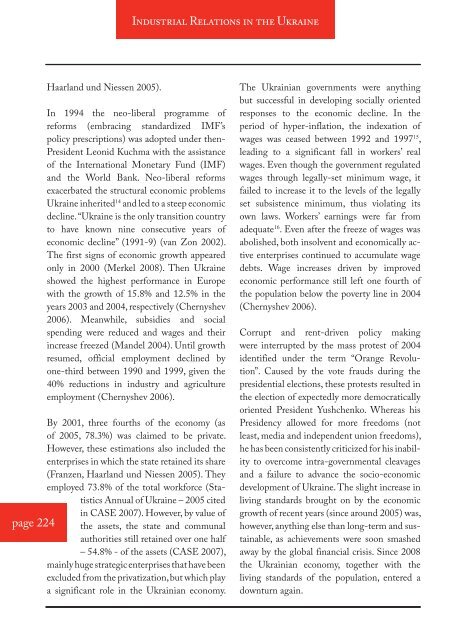Heft36 1 - SFB 580 - Friedrich-Schiller-Universität Jena
Heft36 1 - SFB 580 - Friedrich-Schiller-Universität Jena
Heft36 1 - SFB 580 - Friedrich-Schiller-Universität Jena
You also want an ePaper? Increase the reach of your titles
YUMPU automatically turns print PDFs into web optimized ePapers that Google loves.
INDUSTRIAL RELATIONS REFERENCES LITERATUR IN THE UKRAINE<br />
Haarland und Niessen 2005).<br />
In 1994 the neo-liberal programme of<br />
reforms (embracing standardized IMF’s<br />
policy prescriptions) was adopted under then-<br />
President Leonid Kuchma with the assistance<br />
of the International Monetary Fund (IMF)<br />
and the World Bank. Neo-liberal reforms<br />
exacerbated the structural economic problems<br />
Ukraine inherited 14 and led to a steep economic<br />
decline. “Ukraine is the only transition country<br />
to have known nine consecutive years of<br />
economic decline” (1991-9) (van Zon 2002).<br />
The first signs of economic growth appeared<br />
only in 2000 (Merkel 2008). Then Ukraine<br />
showed the highest performance in Europe<br />
with the growth of 15.8% and 12.5% in the<br />
years 2003 and 2004, respectively (Chernyshev<br />
2006). Meanwhile, subsidies and social<br />
spending were reduced and wages and their<br />
increase freezed (Mandel 2004). Until growth<br />
resumed, official employment declined by<br />
one-third between 1990 and 1999, given the<br />
40% reductions in industry and agriculture<br />
employment (Chernyshev 2006).<br />
By 2001, three fourths of the economy (as<br />
of 2005, 78.3%) was claimed to be private.<br />
However, these estimations also included the<br />
enterprises in which the state retained its share<br />
(Franzen, Haarland und Niessen 2005). They<br />
employed 73.8% of the total workforce (Statistics<br />
Annual of Ukraine – 2005 cited<br />
in CASE 2007). However, by value of<br />
Seite page 224<br />
the assets, the state and communal<br />
authorities still retained over one half<br />
– 54.8% - of the assets (CASE 2007),<br />
mainly huge strategic enterprises that have been<br />
excluded from the privatization, but which play<br />
a significant role in the Ukrainian economy.<br />
The Ukrainian governments were anything<br />
but successful in developing socially oriented<br />
responses to the economic decline. In the<br />
period of hyper-inflation, the indexation of<br />
wages was ceased between 1992 and 1997 15 ,<br />
leading to a significant fall in workers’ real<br />
wages. Even though the government regulated<br />
wages through legally-set minimum wage, it<br />
failed to increase it to the levels of the legally<br />
set subsistence minimum, thus violating its<br />
own laws. Workers’ earnings were far from<br />
adequate 16 . Even after the freeze of wages was<br />
abolished, both insolvent and economically active<br />
enterprises continued to accumulate wage<br />
debts. Wage increases driven by improved<br />
economic performance still left one fourth of<br />
the population below the poverty line in 2004<br />
(Chernyshev 2006).<br />
Corrupt and rent-driven policy making<br />
were interrupted by the mass protest of 2004<br />
identified under the term “Orange Revolution”.<br />
Caused by the vote frauds during the<br />
presidential elections, these protests resulted in<br />
the election of expectedly more democratically<br />
oriented President Yushchenko. Whereas his<br />
Presidency allowed for more freedoms (not<br />
least, media and independent union freedoms),<br />
he has been consistently criticized for his inability<br />
to overcome intra-governmental cleavages<br />
and a failure to advance the socio-economic<br />
development of Ukraine. The slight increase in<br />
living standards brought on by the economic<br />
growth of recent years (since around 2005) was,<br />
however, anything else than long-term and sustainable,<br />
as achievements were soon smashed<br />
away by the global financial crisis. Since 2008<br />
the Ukrainian economy, together with the<br />
living standards of the population, entered a<br />
downturn again.
















